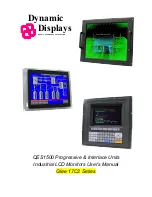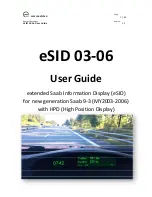
CET s.r.l. Parallel Message Display
page 9
2.3.6. Command TYPE 13: Sub-message display in BCD code
Using this command, you can recall a message to the second display line together with the message that is
already displayed at the moment.
This enables two different messages being displayed at the same time. Should one or both messages be longer
than 20 characters, the text will automatically scroll from right to left.
To remove the message from the second line, send back the same command recalling message no. 0.
N.B.
This command is not implemented in the displays with two 40-character lines.
Inputs
SY
D
C
B
A
Command TYPE 13
IMP
1
1
0
1
This coding requires entering the message recall number in BCD code:
D8
D7
D6
D5
D4
D3
D2
D1
D0
2
8
2
7
2
6
2
5
2
4
2
3
2
2
2
1
2
0
3
rd
2
nd
1
st
3
rd
DIGIT
2
nd
DIGIT
1
st
DIGIT
Number in the range 0 to 199
Coding and number are always read at the variation 0 1 of the synchronism signal SY.
2.4. ENTERING VARIABLES IN THE TEXT DISPLAYED
Certain characters can be entered from the PLC into the texts of all messages recalled onto the display to
compose a word, sentence or number; such writings are called VARIABLES, as they are continuously varied
(updated). Management and, consequently, entering of such VARIABLES in the message display unit is rather
sophisticated in order to guarantee the PLC easy and efficient display control.
First of all, it is necessary to identify in advance the positions in the text where the variables are to be entered
and leave them free for writing. This can be done for a part of the text or for the whole text that appears on the
display.
In any case, variables can only be entered within the display length and no more.
For example, if the display is composed of 40 characters, only 40 positions can be managed as variables.
The commands that are to be transmitted from the PLC to the message display unit and contain the VARIABLE,
basically consist in CHARACTER and ADDRESS.
THE ADDRESS (from 0 to n, where n is the text length) represents the position in the text where the letter,
symbol or number shall be entered.
THE CHARACTER is the letter, symbol or number if in ASCII code or only the number if in BCD code (from 0 to
9).
Variables are ENTERED through commands TYPE 2 - 3 - 4 - 5.
NOTE: variables in scroll messages are updated only when they are actually displayed; all changes entered when
they are not displayed are ignored.










































